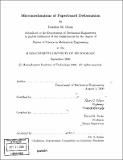| dc.contributor.advisor | Mary C. Boyce and David M. Parks. | en_US |
| dc.contributor.author | Dunn, Heather M. (Heather Margaret), 1976- | en_US |
| dc.contributor.other | Massachusetts Institute of Technology. Dept. of Mechanical Engineering. | en_US |
| dc.date.accessioned | 2010-01-07T21:03:48Z | |
| dc.date.available | 2010-01-07T21:03:48Z | |
| dc.date.copyright | 2000 | en_US |
| dc.date.issued | 2000 | en_US |
| dc.identifier.uri | http://hdl.handle.net/1721.1/50630 | |
| dc.description | Thesis (S.M.)--Massachusetts Institute of Technology, Dept. of Mechanical Engineering, 2000. | en_US |
| dc.description | Includes bibliographical references (p. 245-246). | en_US |
| dc.description.abstract | An experimental study of the micromechanisms of paperboard deformation has been conducted. Experiments were performed in a scanning electron microscope, allowing visual observation and coincident acquisition of load vs. deformation data. Deformation mechanisms were determined and correlated with features of the load vs. deformation curves for different loading modes. A macroscopic study was performed concurrently to provide accurate continuum-level load vs. deformation data. This study contributed to an effort to model the creasing process. In creasing, paperboard is punched to create an internal line of damage and then folded along that line to create a corner. It has been determined experimentally that the creasing process involves through-thickness compression and transverse shear loading, as well as in-plane tension loading. Out-of-plane delamination also plays an important role. Experiments were conducted to determine the stress-strain behavior and corresponding deformation mechanisms under several well-controlled loading conditions. These include through-thickness compression, shear, and tension, as well as combined tension/shear loading. In-plane tensile behavior was also investigated. Paperboard loaded in out-of-plane compression behaved linearly at small strains, with an exponential increase in stiffness at larger strains. Deformation mechanisms included void closure and fiber collapse. In out-of-plane shear, paperboard initially behaved linearly, but departed from linearity before a peak in load. The dominant failure mechanism at the microscopic scale was sudden fiber disengagement throughout the entire cross-section, corresponding to the peak in load. Loaded in out-of-plane tension, the paperboard first exhibited many small cracks at the interfaces between layers. As these cracks grew, one became dominant, and all further delamination occurred by extension of that crack. Similar behavior was observed in combined loading experiments with tension as the larger load component. With shear as the larger component, delamination generally occurred suddenly rather than being preceded by small local cracks. In-plane tensile behavior also included an initial linear region, followed by nonlinearity and a peak in load. The dominant mechanisms were fiber break and fiber disengagement in the different layers of the board; this again corresponded to the ... [missing rest of abstract] | en_US |
| dc.description.statementofresponsibility | by Heather M. Dunn. | en_US |
| dc.format.extent | 246 p. | en_US |
| dc.language.iso | eng | en_US |
| dc.publisher | Massachusetts Institute of Technology | en_US |
| dc.rights | M.I.T. theses are protected by
copyright. They may be viewed from this source for any purpose, but
reproduction or distribution in any format is prohibited without written
permission. See provided URL for inquiries about permission. | en_US |
| dc.rights.uri | http://dspace.mit.edu/handle/1721.1/7582 | en_US |
| dc.subject | Mechanical Engineering. | en_US |
| dc.title | Micromechanisms of paperboard deformation | en_US |
| dc.type | Thesis | en_US |
| dc.description.degree | S.M. | en_US |
| dc.contributor.department | Massachusetts Institute of Technology. Department of Mechanical Engineering | |
| dc.identifier.oclc | 48380445 | en_US |

